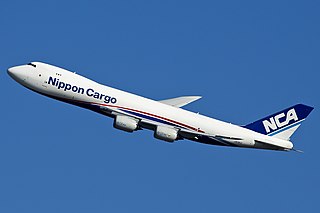
The Boeing 767 is an American wide-body aircraft developed and manufactured by Boeing Commercial Airplanes. The aircraft was launched as the 7X7 program on July 14, 1978, the prototype first flew on September 26, 1981, and it was certified on July 30, 1982. The initial 767-200 variant entered service on September 8, 1982, with United Airlines, and the extended-range 767-200ER in 1984. It was stretched into the 767-300 in October 1986, followed by the extended-range 767-300ER in 1988, the most popular variant. The 767-300F, a production freighter version, debuted in October 1995. It was stretched again into the 767-400ER from September 2000.

The Boeing 747 is a large, long-range wide-body airliner designed and manufactured by Boeing Commercial Airplanes in the United States between 1968 and 2023. After introducing the 707 in October 1958, Pan Am wanted a jet 2+1⁄2 times its size, to reduce its seat cost by 30%. In 1965, Joe Sutter left the 737 development program to design the 747. In April 1966, Pan Am ordered 25 Boeing 747-100 aircraft, and in late 1966, Pratt & Whitney agreed to develop the JT9D engine, a high-bypass turbofan. On September 30, 1968, the first 747 was rolled out of the custom-built Everett Plant, the world's largest building by volume. The first flight took place on February 9, 1969, and the 747 was certified in December of that year. It entered service with Pan Am on January 22, 1970. The 747 was the first airplane called a "Jumbo Jet" as the first wide-body airliner.

An airliner is a type of aircraft for transporting passengers and air cargo. Such aircraft are most often operated by airlines. Although the definition of an airliner can vary from country to country, an airliner is typically defined as an airplane intended for carrying multiple passengers or cargo in commercial service. The largest of them are wide-body jets which are also called twin-aisle because they generally have two separate aisles running from the front to the back of the passenger cabin. These are usually used for long-haul flights between airline hubs and major cities. A smaller, more common class of airliners is the narrow-body or single-aisle. These are generally used for short to medium-distance flights with fewer passengers than their wide-body counterparts.

The Boeing 757 is an American narrow-body airliner designed and built by Boeing Commercial Airplanes. The then-named 7N7, a twinjet successor for the trijet 727, received its first orders in August 1978. The prototype completed its maiden flight on February 19, 1982, and it was FAA certified on December 21, 1982. Eastern Air Lines placed the initial 757-200 variant in commercial service on January 1, 1983. A package freighter (PF) variant entered service in September 1987 and a combi model in September 1988. The stretched 757-300 was launched in September 1996 and began service in March 1999. After 1,050 had been built for 54 customers, production ended in October 2004, while Boeing offered the largest 737 NG variants as a successor.

A cockpit or flight deck is the area, on the front part of an aircraft or spacecraft, from which a pilot controls the aircraft.

The Airbus A310 is a wide-body aircraft, designed and manufactured by Airbus Industrie, then a consortium of European aerospace manufacturers. Airbus had identified a demand for an aircraft smaller than the A300, the first twin-jet wide-body. On 7 July 1978, the A310 was launched with orders from Swissair and Lufthansa. On 3 April 1982, the first prototype conducted its maiden flight, and the A310 received its type certificate on 11 March 1983.

The Airbus A300-600ST, or Beluga, is a specialised wide-body airliner used to transport aircraft parts and outsize cargoes. It received the official name of Super Transporter early on, but its nickname, after the beluga whale, which it resembles, gained popularity and has since been officially adopted.
Condor Flugdienst GmbH, usually shortended to Condor, is a German leisure airline established in 1955 with Frankfurt Airport being its main base. Condor offers scheduled flights to leisure destinations and operates, from Germany, medium-haul flights to the Mediterranean Basin and the Canary Islands as well as long-haul flights to destinations in Africa, Asia, North America, South America and the Caribbean. Whereas medium-haul flights are operated from many German airports, long-haul flights usually depart from Frankfurt, with a few rotations operated from Düsseldorf and Munich. Condor also operates charter flights.

The McDonnell Douglas MD-11 is an American tri-jet wide-body airliner manufactured by American manufacturer McDonnell Douglas (MDC) and later by Boeing. Following DC-10 development studies, the MD-11 program was launched on December 30, 1986. Assembly of the first prototype began on March 9, 1988. Its maiden flight occurred on January 10, 1990, and it achieved Federal Aviation Administration (FAA) certification on November 8. The first delivery was to Finnair on December 7 and it entered service on December 20, 1990.

The Boeing 747-400 is a large, long-range wide-body airliner produced by Boeing Commercial Airplanes, an advanced variant of the initial Boeing 747. The "Advanced Series 300" was announced at the September 1984 Farnborough Airshow, targeting a 10% cost reduction with more efficient engines and 1,000 nautical miles [nmi] of additional range. Northwest Airlines became the first customer with an order for 10 aircraft on October 22, 1985. The first 747-400 was rolled out on January 26, 1988, and made its maiden flight on April 29, 1988. Type certification was received on January 9, 1989, and it entered service with NWA on February 9, 1989.

Etihad Airways is one of two flag carriers of the United Arab Emirates. Its head office is in Khalifa City, Abu Dhabi, near Abu Dhabi International Airport. The airline commenced operations in November 2003, and is the second-largest airline in the UAE after Emirates. The name Etihad is the Arabic word for 'Union'.

The Airbus A310 MRTT Multi-Role Tanker Transport is a military air-to-air refuelling, or in-flight refuelling tanker transport aircraft, capable of operating multi-role missions. The A310 MRTT tanker aircraft is a subsequent development from the earlier Airbus A310 MRT Multi-Role Transport, which was a military transport aircraft for passengers, cargo, and medical evacuation. The A310 MRT and A310 MRTT are both specialist military conversions of existing airframes of the civilian Airbus A310-300C wide-bodied passenger jet airliner.

United Airlines Flight 811 was a regularly scheduled airline flight from Los Angeles to Sydney, with intermediate stops at Honolulu and Auckland. On February 24, 1989, the Boeing 747-122 serving the flight experienced a cargo-door failure in flight shortly after leaving Honolulu. The resulting explosive decompression blew out several rows of seats, killing nine passengers. The aircraft returned to Honolulu and landed without further incident.

Tasman Cargo Airlines Pty. Limited is an Australian cargo airline with the head office in Sydney, Australia. It operates scheduled international cargo services on behalf of DHL and ad hoc domestic and international cargo charters. Its corporate headquarters are at Sydney Kingsford Smith Airport in the Sydney suburb of Mascot. The fleet of aircraft are Boeing 767 based at different airports in Australia and New Zealand.
Lufthansa CityLine GmbH is a German airline with its headquarters on the grounds of Munich Airport. It is a wholly owned subsidiary of Lufthansa and maintains hubs at Frankfurt Airport and Munich Airport, from where it operates a dense domestic and European network as a member of Lufthansa Regional.

Evergreen International Airlines was a charter and cargo airline based in McMinnville, Oregon, United States. Wholly owned by Evergreen International Aviation, it had longstanding ties to the Central Intelligence Agency (CIA). It operated contract freight services, offering charters and scheduled flights, as well as wet lease services. It operated services for the U.S. military and the United States Postal Service, as well as ad hoc charter flights. Its crew base was at John F. Kennedy International Airport, New York.

The Boeing 747-8 is the last series of the large, long-range wide-body airliners in the Boeing 747 family from Boeing Commercial Airplanes. After introducing the 747-400, Boeing considered larger 747 versions as alternatives to the proposed double-deck Airbus A3XX, later developed as the Airbus A380. The stretched 747 Advanced was launched as the 747-8 on November 14, 2005, for a market forecast of 300 aircraft. The first 747-8F Freighter performed its maiden flight on February 8, 2010, and the passenger 747-8I Intercontinental followed suit on March 20, 2011. The cargo version was first delivered in October 2011 and the airliner began commercial service in June 2012.

German Cargo Services GmbH, operating as German Cargo, was an airline from (West) Germany that operated cargo flights on behalf of Lufthansa, of which it was a wholly owned subsidiary.

Lufthansa Technik AG provides worldwide maintenance, repair, and overhaul (MRO) services for aircraft, engines, and components. It is a subsidiary of the Lufthansa Group.

James David Raisbeck was an American aeronautical engineer, known for his entrepreneurship in developing products which enhance the performance of production aircraft.

















